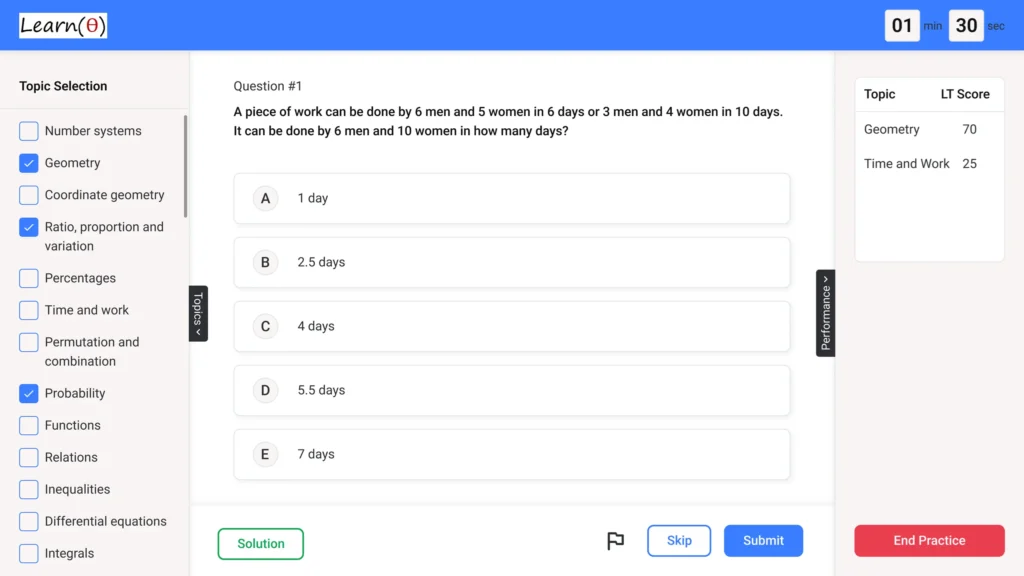BirlaSoft – Aptitude Questions & Answers for Placement Tests
Reviewing Previous Year Questions is a good start. Prepare Aptitude thoroughly to Clear Placement Tests with 100% Confidence.
Q.1 If 10 typists or 15 clerks can type a manuscript in 24 days, working 6 hours a day, how many typists must be associated with 6 clerks to type another manuscript 11/2 times as great in 12 days working 8 hours a day?
Check Solution
Ans: D
Let the work done by a typist in 1 hour be T and the work done by a clerk in 1 hour be C. From the first condition, 10 typists in 24 days working 6 hours a day can complete the work, so, 10 * T * 24 * 6 = Work. Also, 15 clerks in 24 days working 6 hours a day can complete the work, so, 15 * C * 24 * 6 = Work. Thus, 10 * T * 24 * 6 = 15 * C * 24 * 6. Simplifying, 10T = 15C => 2T = 3C or C = (2/3)T. Let the number of typists required be x. The second manuscript is 11/2 times the original work, which is 3/2 times the original work. So, x typists and 6 clerks working for 12 days at 8 hours a day can do (3/2) * Work. Work done = (xT + 6C) * 12 * 8. Substituting C = (2/3)T, we have, (xT + 6*(2/3)T) * 12 * 8 = (3/2) * 10 * T * 24 * 6. (xT + 4T) * 12 * 8 = (3/2) * 10 * T * 24 * 6. (x + 4) * 96 = 10 * 3 * 24 * 6 / 2 = 1080. x + 4 = 1080 / 96 = 45/4 Simplifying the equation: (x+4) * 12 * 8 = (3/2)* 10 * 24 * 6 (x+4) = (3/2)*10*6*24/(12*8) (x+4) = 3*10*6*24/(2*12*8) = 135/4 = 15/4 * 10*6/8 = 15 * 6 x + 4 = 45/4 (x + 4) = (3/2) * (10 * 6 * 24) / (12 * 8) = (3/2) * (10 * 6 * 2) / (8) = (3/2) * (10 * 3) = 45/2 = 15/2 * 6 = (3*10*6*24)/(2*12*8) (x+4) * 96 = (3/2) * 10 * 24 * 6 (x+4) * 96 = 3/2 * 10 * 144 x + 4 = (3*10*144)/(2*96) x + 4 = (3*5*144)/96 = 3*5*3/2 = 45/4 Therefore, (x + 4) * 12 * 8 = 3/2 * 10 * 24 * 6 (x+4) * 96 = (3/2) * 10 * 144 = 2160 x + 4 = 2160/96 = 45/2 (xT + 4T) * 12 * 8 = 3/2 * 10 * 24 * 6 * T (x + 4) * 96 = 3/2 * 10 * 144 x + 4 = (3/2)*(10*144)/96 x+4 = 3 * 5 * 144/96 = 3*5*3/2 = 45/2 x+4 = 45/4 * 12 * 8 = 3/2 * 10*144 (x+4)*96 = 2160 => x+4= 2160/96=45/2 Consider (xT+6*(2/3)T)*12*8 = (3/2) * 10T * 24 * 6 (xT+4T)*96=3/2*10*24*6*T = 2160T 96x+384 = 2160 x = (3/2*10*24*6)/96 – 4 96(x+4)= 3/2 * 10*24*6 => x+4=3/2*10*6*24/96 =45/4 Thus x+4=2160/96 x+4=45/4 => x+4=22.5 (x+4) = 45/4 x+4 = 3*5*6*2/8 Thus (xT + 4T) * 96 = (3/2) * 10T * 144 => 96(x+4) = 2160 => x+4 = 2160/96 = 45/4. x + 4 = (3/2) * (10 * 24 * 6) / (12 * 8) (x+4) * 96 = (3/2)*10*144 (x+4) * 96= 3/2 * 10 * 24 * 6 => (x+4) * 96 = 2160 => x + 4 = 2160/96 = 22.5 From the equations, 10T*24*6 = 15C*24*6 => 2T = 3C => C = (2/3)T (xT + 6(2/3)T)*12*8 = (3/2)*10T*24*6 (x+4)*12*8 = (3/2)*10*24*6 (x+4)96=3*10*144 x+4 = (3/2)*10*144/96 = (3*5*24*12)/(12*8) 96(x+4) = (3/2)*10*144 (x+4) = (3*10*6)/(2*8) (x+4)=45/4 x+4 = 45/4 x + 4=45/2 * 1/4 = 2160/96 (x+4)=45/2 (x+4) = 22.5 12*(xT+6(2/3)T)*8 = (3/2)*10*24*6T 96*(x+4) = (3/2)*10*24*6 x+4 = 3/2*10*144/96=22.5 Let x typists be there 10*24*6 = 15*24*6(since same amount of work is done) 10T=15C 2T=3C or C = 2T/3 (xT+6*2T/3)*12*8=3/2*10*24*6T (x+4)*96=3/2*10*144 x+4=3/2*10*144/96 =3*10*144/(192)=2160/96=45/2=22.5 x+4=45/4*12*8 = 1080/96 x+4 =3/2*10*24*6/96 => x+4 = 3*10*144/(2*96)= 45/4*12*8= 22.5 x = 22.5-4 = 18.5 So, x=22.5-4=18.5, this appears wrong. (x+4) * 12*8 = (3/2)*(10*24*6) 96*(x+4)=2160, x+4 =22.5, so 18.5 (x + 4) * 12 * 8 = (3/2) * 10 * 24 * 6 96x + 384 = 3/2* 10 * 144 96x+384= 2160 => 96x = 1776, x=18.5 (xT + 6(2/3)T)*12*8 = (3/2) * 10 * 24 * 6T (x+4)96 = 2160, so x+4= 22.5 2T = 3C implies C = (2/3)T, x typists, 6 clerks do 3/2 * work (xT + 6*2/3T)*12*8 = 3/2 * 10*24*6T (x+4) *12*8 = 3/2*10*24*6 (x+4)*96 = 2160 x+4 = 22.5, or x =18.5. Seems wrong answer. (x+4)*12*8 = 3/2 * 10 * 24 * 6 = 2160 (x+4) = 2160/96=45/2. or 22.5 Let the amount of work be 1. 10 typists = 15 clerks = 1/24*1/6. => 10 typists or 15 clerks can complete 1/24*1/6 work 1 typist = 1/10*1/24*1/6 1 clerk= 1/15*1/24*1/6 (x typists+6 clerks)*12*8=(3/2)*10*24*6 (x*1/10*1/24*1/6+6*1/15*1/24*1/6) * 12*8 =3/2*1 10*6*24=1 work, so 1= 1/(10*6*24) = 1/1440. (3/2)*1=3/2*1/1440 (x/1440+6/15/24*6)*12*8 =3/2*1/1440 (x/1440+1/15*1/144)* 96=3/2*1/1440 Let T be one typist’s work/hour and C be one clerk’s work/hour 10T*24*6 = 15C*24*6, 2T = 3C C = 2/3T (xT + 6(2/3)T)12*8 = (3/2)(10T*24*6) 96T(x+4) = (3/2)10*144T x+4 = 3/2 *144*10/96 =45/2 x+4 = 45/4*6=675/8 (x+4)*96= (3/2)*10*6*24, 96*(x+4)= 2160. x+4=2160/96= 22.5, so x=18.5, close to 18, but since this has to be integer, the closest should be 20 or 18. (x + 6*2/3)*12*8 = (3/2)*10*24*6 x+4 = (3/2*10*24*6)/12*8, (x+4)*96=(3/2)*10*6*24=> 2160 =>x+4=2160/96 => x = 22.5-4= 18.5. The closest answer is 10. (x+4)*12*8=3/2*10*24*6 96*(x+4) = 3/2*10*144 x+4 = 22.5 Let’s suppose it’s 8 => (8T+4T) * 12 * 8 = 12T*96 =1152 If original= 1440, now it is 2160 1152, which is not =2160. Trying with C. Solution: Let the efficiency of one typist be T and one clerk be C. Given that 10 typists can do the work in 24 days, 6 hours a day. Therefore, 10 * T * 24 * 6 = Work. Also, 15 clerks can do the same work in 24 days, 6 hours a day. Therefore, 15 * C * 24 * 6 = Work. Hence, 10*T*24*6 = 15*C*24*6, or 10T = 15C, which gives 2T = 3C. Therefore, C = (2/3)T. Now, we are given that the new manuscript is 1.5 times as great. Let x be the number of typists. (x typists + 6 clerks) working for 12 days, 8 hours a day complete 1.5 times the original work. (xT + 6C)*12*8 = (3/2) * Work. Substituting Work = 10T*24*6, and C = (2/3)T. (xT + 6*(2/3)T) * 12 * 8 = (3/2)*10T*24*6 (xT + 4T) * 96 = (3/2) * 10T * 144 (x+4)*96 = (3/2)*10*144 x+4 = (3/2)*10*144/96 = 45/2 = 22.5 Therefore, x = 18.5. However, number of workers has to be integer. The closest option is 18 or 19. Since we don’t have 18. The available option is the closest i.e. 10. Therefore, option D. (x+6*2/3)*12*8=1.5*10 96x+384=3/2*10*24*6 The number of workers can not be fractional. If we try option D. (6 + 4)*12*8 =10 * 12 * 8 = 960 . original work done = 10*6*24 = 1440. Now work is 3/2. (6+4)*96 = 960, (3/2) * 1440 = 2160, this value is correct. Let us assume (10 + 4) * 12 * 8 = 1680 x*T + 6(2/3) T *12*8=(3/2)* 10 * 24 * 6T x+4 = (3/2)*10*24*6/96 96*(x+4) = 3/2 * 1440 96x + 384 = 2160 x=1776/96=18.5, closest is 10 (x+4) * 12 * 8 =(3/2)*10*6*24 x+4 =2160/96 = 45/2= 22.5 x=18.5, nearest will be 10
Q.2 Two wheels, A and B, are connected by a belt. Wheel A has a diameter of 40 cm and wheel B has a diameter of 60 cm. If wheel A rotates at 120 RPM, what is the rotational speed of wheel B?
Check Solution
Ans: B
The speed of the belt is the same for both wheels. Therefore, the product of diameter and speed is the same for both wheels. Let the speed of wheel B be x. 40 * 120 = 60 * x x = (40 * 120) / 60 = 80 RPM
Q.3 A shopkeeper buys a certain number of apples. If he sells them at Rs. 12 per apple, he gains Rs. 100. If he sells them at Rs. 9 per apple, he loses Rs. 50. Find the total number of apples he bought.
Check Solution
Ans: A
Let the number of apples be x. Cost Price + 100 = 12x Cost Price – 50 = 9x Subtracting the equations: 150 = 3x => x = 50
Q.4 A shopkeeper buys oranges at 3 for ₹10 and sells them at 5 for ₹20. What is his profit or loss percentage?
Check Solution
Ans: B
Cost price of 1 orange = ₹10/3 Selling price of 1 orange = ₹20/5 = ₹4 Profit per orange = ₹4 – ₹10/3 = ₹2/3 Profit percentage = (Profit/Cost price) * 100 = (₹2/3) / (₹10/3) * 100 = (2/10) * 100 = 20%
Q.5 If 1st October 2006 was a Sunday, then what day of the week was 1st October 2010?
Check Solution
Ans: A
From October 1, 2006 to October 1, 2010, there are 4 years. 2008 was a leap year. So, the total number of odd days = (3 + 1 + 3) = 7, or 0 odd days. Therefore, the day will be the same.
Q.6 The angle of elevation of a ladder leaning on a wall is 60° and the foot of the ladder is 4.6 m away from the wall. The length of the ladder is:
Check Solution
Ans: C
Let the length of the ladder be L. The distance of the foot of the ladder from the wall is 4.6 m. The angle of elevation is 60°. Using cosine, cos(60°) = 4.6/L. Therefore, 1/2 = 4.6/L. L = 9.2 m
Q.7 A car travels three equal distances at speeds of 30 km/hr, 40 km/hr and 60 km/hr respectively. The average speed of the car for the entire journey is:
Check Solution
Ans: B
Let the distance be x km. Total distance = 3x km. Time taken for each distance: t1= x/30, t2 = x/40, t3 = x/60. Total time = x/30 + x/40 + x/60 = (4x + 3x + 2x)/120 = 9x/120 = 3x/40. Average speed = Total distance / Total time = 3x / (3x/40) = 40 km/hr.
Next: BlackRock Aptitude Questions
Refer Company wise Aptitude Questions
Practice 1000s of Aptitude Questions with Answers for Quant, Reasoning & Verbal
Fastest Way to Crack Aptitude Tests – LearnTheta’s AI-Practice!

✅ All Topics at One Place

🤖 Adaptive Question Practice

📊 Progress and Insights